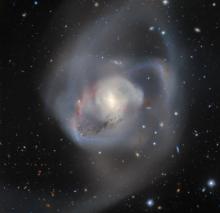Listen to today's episode of StarDate on the web the same day it airs in high-quality streaming audio without any extra ads or announcements. Choose a $8 one-month pass, or listen every day for a year for just $30.
You are here
Void Galaxy
Most of the universe consists of empty space — enormous volumes of darkness that harbor few stars or galaxies at all. We live next to a void. It’s called the Local Void, and it starts about four million light-years away, on the other side of our home galaxy, the Milky Way. This region of darkness is gargantuan: It spans an incredible quarter of a billion light-years.
The Local Void isn’t completely empty, though. It houses a few lonely galaxies. And despite their peculiar location, they seem perfectly ordinary.
The nearest known inhabitant of the Local Void is a dwarf galaxy known as KK 246. The galaxy is 23 million light-years from Earth — about 10 times farther than the Andromeda galaxy, which is the nearest giant galaxy to our own.
Like most galaxies, KK 246 is much smaller and fainter than the Milky Way. And as far as we can tell, it has no neighbors within 10 million light-years. In contrast, more than a hundred galaxies lie within that same distance of the Milky Way.
But like our galaxy, KK 246 contains gas that’s giving birth to new stars. Dwarf galaxies that lie near big ones often lose their gas to the giants. But with no neighbors, KK 246 doesn’t have that problem. It’s simply an average-looking small galaxy in the middle of nowhere — in the vast emptiness of the Local Void.
The galaxy is in Sagittarius, which is low in the south at nightfall. Its stars form the outline of a teapot.
Script by Ken Croswell





